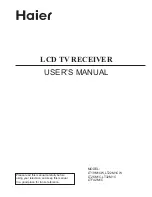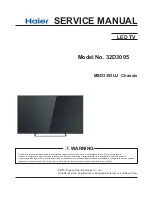
3
Getting started
EN
1.
Insert two LR03 or AAA batteries in the remote control.
Precautions on using batteries:
- Only use the battery types specified.
- Make sure you use the correct polarity.
- Do not mix new and used batteries.
- Do not use rechargeable batteries.
- Do not expose batteries to excessive heat, throw them in a fire, recharge them or
try to open them, as this could cause them to leak or explode.
- Remove the batteries from the remote control if you are not using it for a long
period of time (several weeks).
2.
Plug the female socket on the mains lead into the mains adapter.
3.
Connect the mains adapter to the power socket on the back of the
TV set (towards the left).
This supplies electricity to the TV set, which must be powered exclusively by a 12V or
24V DC supply (depending on the model).
4.
Plug the male plug on the mains lead into a 220 - 240V ~ AC 50Hz
mains outlet.
Equipment for the UK and Ireland is supplied with a mains cable fitted with a
moulded plug.
This plug contains safety components and must not be replaced by one sold by
general retailers. It is fitted with a fuse that protects your television. If your set has
stopped working, the fuse may have blown. If it has, replace it with an identical ASTA
or BSI certified (BS1362) 5-amp fuse.
5.
Connect the outside aerial or cable network to the
socket at the
back of the TV set.
The aerial socket (75 Ohms - VHF / UHF / cable) can be used for connecting an
external aerial or other equipment fitted with a modulator (video recorder, satellite
receiver, etc.).
We recommend that you do not connect other equipment (video recorder, satellite
receiver, etc.) to your TV set to begin with, so as not to complicate the set-up
procedure with the additional steps involved. Connect them when you have finished
setting up the channels by referring to page 14 of this manual.
6.
Switch the TV on by pressing the on/standby button
B
on the front.
You will find a description of how to use the remote control on page 4.
Then go to page 6 for information on the initial set-up, or to page 7 for
information on manual set-up (if the channels have already been set up
on your TV).
Please respect the environment and the relevant regulations. Before you
dispose of batteries (or accumulators), ask your dealer whether they require
special recycling and if he is able to take them back.
g
Switching on
Follow the instructions on this page on how to switch on your TV set and the remote control before going on to following
pages describing how to use the remote control and the channel set-up procedure.
5A
220 - 240 V ~ 50 Hz
Mains socket in
continental Europe
Mains socket for
UK and Ireland
Audio in
06-EFC030-EN.qxd 15/06/05 13:40 Page 3

































